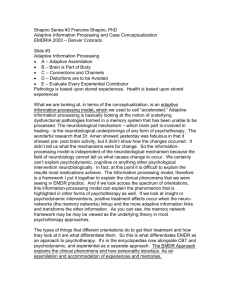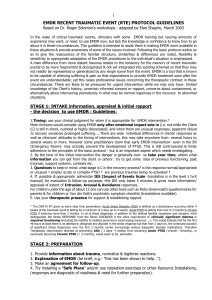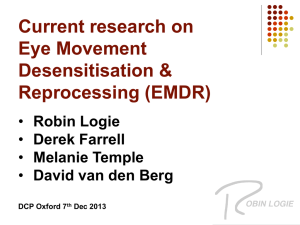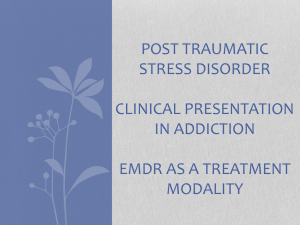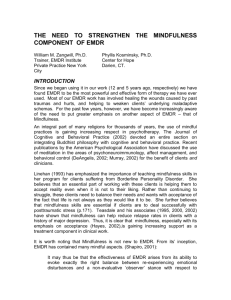I confirm that the Applicant for Accreditation for EMDR Europe
advertisement
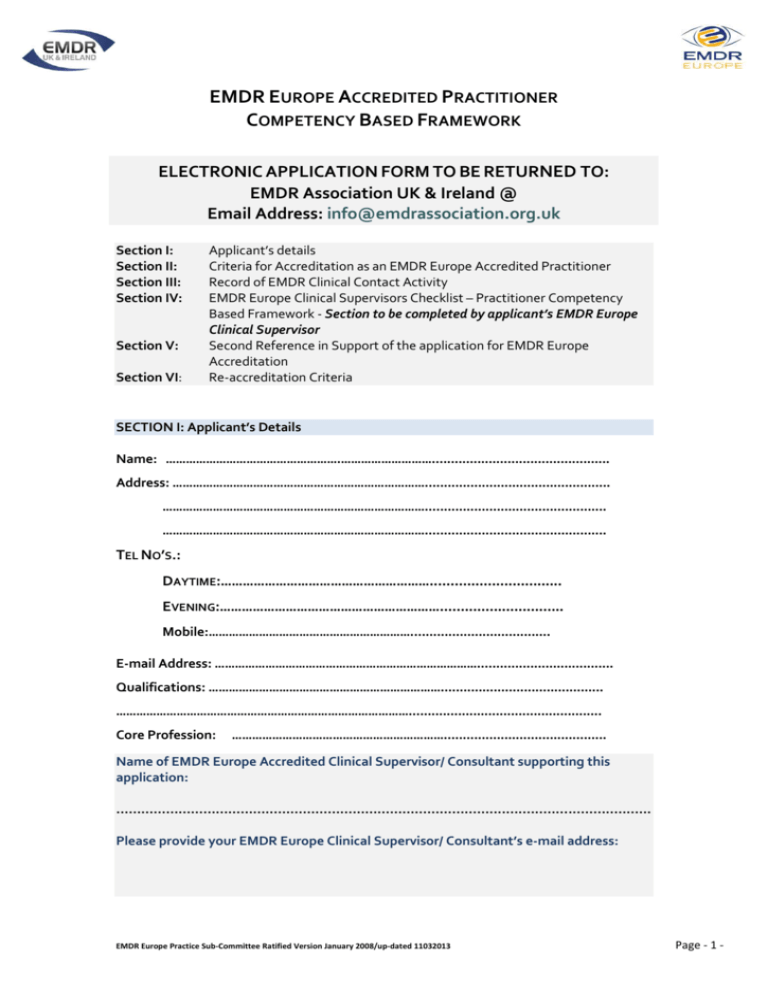
EMDR EUROPE ACCREDITED PRACTITIONER COMPETENCY BASED FRAMEWORK ELECTRONIC APPLICATION FORM TO BE RETURNED TO: EMDR Association UK & Ireland @ Email Address: info@emdrassociation.org.uk Section I: Section II: Section III: Section IV: Section V: Section VI: Applicant’s details Criteria for Accreditation as an EMDR Europe Accredited Practitioner Record of EMDR Clinical Contact Activity EMDR Europe Clinical Supervisors Checklist – Practitioner Competency Based Framework - Section to be completed by applicant’s EMDR Europe Clinical Supervisor Second Reference in Support of the application for EMDR Europe Accreditation Re-accreditation Criteria SECTION I: Applicant’s Details Name: …………………………………………….………………………............................................... Address: …………………………………………………………………................................................. ……………………………………………………………………................................................ ……………………………………………………………………................................................ TEL NO’S.: DAYTIME:…………………………………………………................................ EVENING:…………………………………………………….............................. Mobile:……………………………………………………..................................... E-mail Address: …………………………………………………………………….................................... Qualifications: ……………………………………………………………........................................... ……………………………………………………………………………................................................... Core Profession: ………………………………………………………........................................... Name of EMDR Europe Accredited Clinical Supervisor/ Consultant supporting this application: ………………………………………………………………………………....................................... Please provide your EMDR Europe Clinical Supervisor/ Consultant’s e-mail address: EMDR Europe Practice Sub-Committee Ratified Version January 2008/up-dated 11032013 Page - 1 - SECTION II: THE FOLLOWING CRITERIA FOR EMDR EUROPE ACCREDITATION MUST BE MET. PLEASE CIRCLE 1. Are you a member of the EMDR Association UK & Ireland? 2. Have you enclosed a copy of your completion of EMDR Basic Training certificate? 3. Additionally have you enclosed copies of your current license/verification/registration as a mental health professional recognised by EMDR Association UK & Ireland? 4. Have you completed a minimum of two year's experience post qualification under criteria (3)? YES NO YES NO YES NO YES NO 5. Please indicate how many years experience have you had after completing EMDR Basic Training? At least one year is required post completion of Total = EMDR Basic Training? 6. Please indicate how many EMDR sessions you have conducted (MINIMUM 50 POST COMMENCING EMDR BASIC TRAINING - Corroborated by an Accredited EMDR Europe Clinical Supervisor)? [Please provide Total = details utilising the enclosed record form - Section III] 7. Please indicate how many clients you have treated with EMDR (MINIMUM 25 POST COMMENCING EMDR BASIC TRAINING - Corroborated by an Accredited EMDR Europe Clinical Supervisor)? [Please provide details Total = utilising the enclosed record form – Section III]. 8. No. of hours EMDR Clinical Supervision - Until the applicant has demonstrated competency in all areas of Parts A, B & C of the Competency Framework. It is estimated that this would require a Total = minimum of 20 hours clinical supervision from an EMDR Europe Accredited Clinical Supervisor 9. The EMDR Clinical Supervisor supervising the applicant has directly witnessed the applicants EMDR work either through the use of video/DVD or In Vivo 10. You have enclosed a reference of recommendation from an Approved EMDR Clinical Supervisor regarding your professional utilisation of EMDR in practice, clinical supervision, consultation, ethics in practice and professional character? (Please refer to Section IV) 11. You have enclosed a second reference in support of your application from a person which is in a position to comments upon your professional practice and standing 12. You have enclosed a cheque payment for £80, made payable to 'EMDR Association UK & Ireland' (non refundable)? EMDR Europe Practice Sub-Committee Ratified Version January 2008/up-dated 11032013 YES NO YES NO YES NO YES NO Page - 2 - 13. Stated your supervisor's name and email address details on page 1? 14.That you are aware that your EMDR Europe Accreditation Certificate is for 5 years duration. After which to continue being EMDR Europe accredited your accreditation will need to be reviewed. This will require documentation of CPD (continuing professional development) activity. The current requirements for this as laid down by EMDR UK & Ireland are ‘THE BIRMINGHAM CRITERIA’ (Refer to Section V). YES NO YES NO 15. Signature of the applicant: Date: EMDR Europe Practice Sub-Committee Ratified Version January 2008/up-dated 11032013 Page - 3 - SECTION III: RECORD OF CLINICAL CONTACTS [Form to be used for both EMDR Europe Practitioners and Consultants] CLIENT'S NUMBER PRESENTING PROBLEM Total = DATE FIRST SEEN NUMBER OF SESSIONs SETTING WHERE TREATMENT TOOK PLACE Total = Name and Signature of EMDR Europe Clinical Supervisor Name and signature of Applicant Date [Please duplicate this page as necessary] EMDR Europe Practice Sub-Committee Ratified Version January 2008/up-dated 11032013 Page - 4 - Section IV: EMDR Clinical Supervisor/ Consultant’s Reference for the EMDR Europe Practitioner Competency Based Framework EMDR CLINICAL SUPERVISOR/ CONSULTANT ACCREDITATION REFERENCE GUIDELINE AND CHECKLIST EMDR CLINICAL SUPERVISOR/ CONSULTANT COMMENTS PLEASE PROVIDE DETAILED COMMENTS IN SUPPORT OF EACH COMPETENCY PART A: Supervisee demonstrates a grounded understanding of the theoretical basis of EMDR and the Adaptive Information Processing (AIP) Model and is able to convey this effectively to clients in providing a treatment overview. PART B: THE BASIC EIGHT- PHASE PROTOCOL 1. History Taking: The Supervisee is able to ascertain an appropriate general history from the client incorporating the following elements: Obtain a history of the origins of the disorder informed by the AIP model including dysfunctional behaviour and symptoms Determine if the client is appropriate for EMDR selection? Identifies ‘red flags’ including screening for Dissociative Disorders. Is able to identify appropriate safety factors including the utilisation (were appropriate) the Dissociative Experience Scale II (DES), Risk Assessment, Life Constraints, Ego Strength, and the availability of support structures Demonstrates an ability to conceptualise the case utilising the AIP model Clarifies the client’s desired state following therapeutic intervention That the client is able to effectively deal with high levels of physical and emotional levels of disturbance To determine appropriate target selection and target sequencing in consideration to the past, present & future In cases of multiple targets to utilise either prioritising or clustering Identify a ‘touchstone’ event that relates to the client’s issue. EMDR Europe Practice Sub-Committee Ratified Version January 2008/up-dated 11032013 Page - 5 - 2. Preparation: The supervisee is able to establish an effective therapeutic relationship in conformance with National or Professional standards and Code of Conduct. The supervisee is effective in: Obtaining informed consent from clients Testing Bilateral Stimulation (BLS) with clients Teaches and checks client’s ability to self-regulate including the utilisation of the safe/secure place and resource installation with clients Makes client’s aware of the ‘Stop’ signal Demonstrates an effective ability in addressing client’s concerns, fears, queries or anxieties Utilisation of an effective metaphor 3. Assessment During the ‘Assessment Phase’ the supervisee determines the components of the target memory and establishes baseline measures for the client’s reactions to the process Selecting target image and worst aspect Identifying the Negative & Positive Cognitions Establishes negative cognitions that are a currently held, negative self-referencing belief, that is irrational, generalisable and has affect resonance that accurately focuses upon the target issue Ensures cognitions are within same domain/ matched category When necessary the supervisee effectively assists the client in ascertaining a pertinent NC & PC Utilises the Validity of Cognition (VOC) scale at an emotional level and in direct relation to the target Identifies emotions generated from the target issue or event Consistent use of the Subjective Units of Disturbance [SUD’s] scale to evaluate the total disturbance Identifying body sensations and location EMDR Europe Practice Sub-Committee Ratified Version January 2008/up-dated 11032013 Page - 6 - 4. Desensitisation During the ‘Desensitisation Phase’ the supervisee processes the dysfunctional material stored in all channels associated with the target event and any ancillary channels: Reminds clients to just ‘notice’ what ever comes up during processing whilst encouraging the client to not discard any information that might be generated. Changes during processing can relate to images, sounds, cognitions, emotions and physical sensations Competency in the provision of Bilateral Stimulation emphasising the importance of eye movements Post ‘Set’ interventions, and evidence of ‘staying out of the way’ as much as possible. Engages in the use of verbal & non-verbal reassurance to client’s during each ‘Set’ Maintaining momentum throughout the desensitisation stage with minimalist intervention where possible Returning to target when appropriate When processing becomes block appropriate interventions are utilised including alteration in the Bilateral Simulation and/or the utilisation of Cognitive Interweaves Please specify examples of effective cognitive interweaves utilised during the Desensitisation Phase’ when processing has become blocked Effectively manages client’s heightened levels of affect utilising both accelerating and de-accelerating interventions. 5. Installation During the ‘Installation Phase’ the supervisee concentrates primarily upon the full integration of a positive selfassessment with the targeted information: The supervisee enhances the Positive Cognition (PC) linked specifically with the target issue or event The Positive Cognition is checked for both applicability and current validity ensuring the PC chosen is the most meaningful to the client Utilisation of the Validity of Cognition scale to evaluate the Positive Cognition Addressing any blocks during the ‘Installation Phase’. If new material emerges supervisee effectively returns to the most appropriate phase of the EMDR Protocol or the utilisation of an ‘Incomplete Session’ EMDR Europe Practice Sub-Committee Ratified Version January 2008/up-dated 11032013 Page - 7 - 6. Body Scan During the ‘Body Scan Phase’ the supervisee considers the link between the client’s original memory/event and the discernable physical resonance that this may generate: The supervisee enables client’s to hold both the memory/ event and the positive cognition in mind whilst mentally scanning their entire body to identify and lingering tension, tightness or unusual sensation and apply Bilateral Stimulation (BLS) The supervisee is prepared for further material to surface and to appropriately respond by either returning to the most appropriate phase of the EMDR Protocol or the utilisation of an ‘Incomplete Session’ 7. Closure The Supervisee should consistently close a session with proper instruction leaving the client in a positive frame of mind and able to safely return home: Allows time for closure Utilisation of the debrief Effective utilisation of the ‘Incomplete Session’ Incorporates appropriate containment exercises and safety assessment Encourages clients to maintain a log between sessions . 8. Re-evaluation of previous session During the ‘Re-evaluation Phase’ the supervisee consistently assesses how well the previously targeted material has been resolved and determines if new processing is necessary. The supervisee actively integrates the targeting session within an overall treatment plan: Returning to previous targets Identifying client evidence of re-adjustment Has the individual target been resolved? Has other material been activated that must be addressed? Have all necessary targets been processed in relation to the past, present and future? Utilisation, when necessary of a ‘Future/ Positive Template’ Has client readjusted appropriately to within their social system? The supervisee effectively terminates therapy EMDR Europe Practice Sub-Committee Ratified Version January 2008/up-dated 11032013 Page - 8 - PART C: 1. 2. 3. Supervisee demonstrates an understanding of PTSD and traumatology Supervisee demonstrates an understanding of using EMDR either as part of a comprehensive therapy intervention or as a means of symptom reduction. Supervisee demonstrates experience in applying the standard EMDR protocol and procedures to special situations and clinical problems, including recent events, phobias, excessive grief and somatic disorders. PART D 1. Please specify the context within which the EMDR Clinical Supervision/ Consultation took place and the number of hours: Face to face [individual] …..….. hours Face to face [Group] ………. hours Telephone………. hours Email………. hours Other…….... hours . 2. Please specify your reasons for recommending your supervisee’s accreditation as an EMDR Europe Practitioner? EMDR Clinical Supervisor/Consultant Signature: ……………..………………………… Please print name: .………………………………………….… Date: ……………………. EMDR Europe Practice Sub-Committee Ratified Version January 2008/up-dated 11032013 Page - 9 - Guidelines for Accreditation as an EMDR Europe Accredited Practitioner Completed EMDR Basic training by a recognised EMDR Europe Trainer Applicants are required to be members of their National EMDR Organisation No. of hours EMDR Clinical Supervision/ Consultation - Until the applicant has demonstrated competency in all areas of Parts A, B & C of the Competency Framework. It is estimated that this would require a minimum of 20 hours clinical supervision from an EMDR Europe Accredited Clinical Supervisor/ Consultant The EMDR Clinical Supervisor/ Consultant supervising the applicant needs to have directly witnessed the applicants EMDR work either through the use of video/DVD or In Vivo No. of EMDR Sessions to be completed by applicant - Minimum 50 No, of clients to be treated with EMDR by the applicant - Minimum 25 No. References to support Application - Two references are required, one from an EMDR Europe Accredited Clinical Supervisor/ Consultant and the second from a person who can comment upon the applicants professional practice and standing. EMDR Europe Practice Sub-Committee January 2008 I confirm that the Applicant for Accreditation for EMDR Europe Accredited Practitioner has completed a minimum of 20 Hours Clinical Supervision/ Consultation: EMDR Clinical Supervisor/Consultant Signature: …….…………………………..................... Please print name: ………………………………...................... Date: …………………………. Supervisee’s Signature: …………………………..................... Date: …………………………. PLEASE NOTE THAT ONLY ELECTRONICALLY COMPLETED DOCUMENTATION WILL BE CONSIDERED. IT IS ESSENTIAL THAT IN ORDER TO CONSIDER YOUR APPLICATION THOROUGHLY PLEASE ENSURE THAT ALL NECESSARY INFORMATION IS PROVIDED. INCOMPLETE APPLICATIONS WILL BE RETURNED TO APPLICANTS. THANK YOU FOR YOUR APPLICATION. MAEVE CROWLEY - CHAIR EMDR UK & IRELAND ACCREDITATION COMMITTEE EMDR Europe Practice Sub-Committee Ratified Version January 2008/up-dated 11032013 Page - 10 - Section V: Second Reference in Support of an Application for EMDR Europe Accreditation This reference forms part of the application process for accreditation as an EMDR Europe Practitioner I support this application for EMDR Europe Accreditation as an EMDR Europe Practitioner for: Name of Applicant:.................................................................................................. I know the applicant from the following context: Please Tick Head of Service/ Clinical Manager Professional Colleague Academic Colleague Clinical Supervision Group member I can confirm the applicants experience in the practice of EMDR and that the applicant’s professional practice is in accordance with the ethical guidelines of their respective professional organisation. Please print name:.................................................................................................... Signature:...................................................................................................... Date:.............................................................................................................. EMDR Europe Practice Sub-Committee Ratified Version January 2008/up-dated 11032013 Page - 11 -
